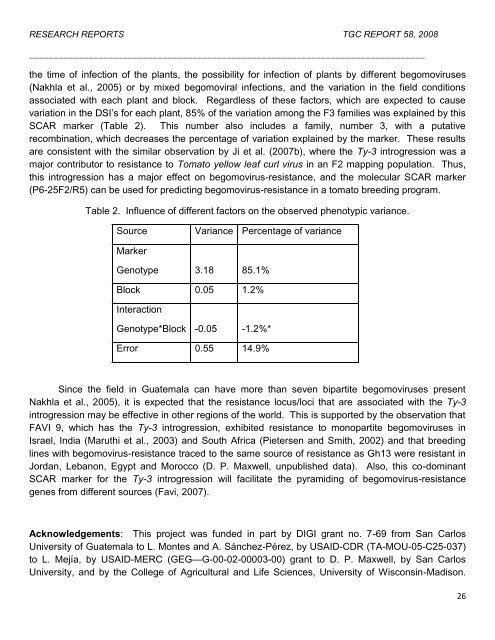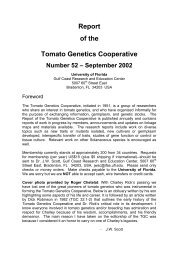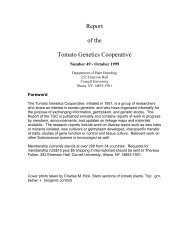RESEARCH REPORTS TGC REPORT <strong>58</strong>, 2008 ________________________________________________________________________________ <strong>the</strong> time <strong>of</strong> infection <strong>of</strong> <strong>the</strong> plants, <strong>the</strong> possibility for infection <strong>of</strong> plants by different begomoviruses (Nakhla et al., 2005) or by mixed begomoviral infections, and <strong>the</strong> variation in <strong>the</strong> field conditions associated with each plant and block. Regardless <strong>of</strong> <strong>the</strong>se factors, which are expected to cause variation in <strong>the</strong> DSI‘s for each plant, 85% <strong>of</strong> <strong>the</strong> variation among <strong>the</strong> F3 families was explained by this SCAR marker (Table 2). This number also includes a family, number 3, with a putative recombination, which decreases <strong>the</strong> percentage <strong>of</strong> variation explained by <strong>the</strong> marker. These results are consistent with <strong>the</strong> similar observation by Ji et al. (2007b), where <strong>the</strong> Ty-3 introgression was a major contributor to resistance to <strong>Tomato</strong> yellow leaf curl virus in an F2 mapping population. Thus, this introgression has a major effect on begomovirus-resistance, and <strong>the</strong> molecular SCAR marker (P6-25F2/R5) can be used for predicting begomovirus-resistance in a tomato breeding program. Table 2. Influence <strong>of</strong> different factors on <strong>the</strong> observed phenotypic variance. Source Variance Percentage <strong>of</strong> variance Marker Genotype 3.18 85.1% Block 0.05 1.2% Interaction Genotype*Block -0.05 -1.2%* Error 0.55 14.9% Since <strong>the</strong> field in Guatemala can have more than seven bipartite begomoviruses present Nakhla et al., 2005), it is expected that <strong>the</strong> resistance locus/loci that are associated with <strong>the</strong> Ty-3 introgression may be effective in o<strong>the</strong>r regions <strong>of</strong> <strong>the</strong> world. This is supported by <strong>the</strong> observation that FAVI 9, which has <strong>the</strong> Ty-3 introgression, exhibited resistance to monopartite begomoviruses in Israel, India (Maruthi et al., 2003) and South Africa (Pietersen and Smith, 2002) and that breeding lines with begomovirus-resistance traced to <strong>the</strong> same source <strong>of</strong> resistance as Gh13 were resistant in Jordan, Lebanon, Egypt and Morocco (D. P. Maxwell, unpublished data). Also, this co-dominant SCAR marker for <strong>the</strong> Ty-3 introgression will facilitate <strong>the</strong> pyramiding <strong>of</strong> begomovirus-resistance genes from different sources (Favi, 2007). Acknowledgements: This project was funded in part by DIGI grant no. 7-69 from San Carlos University <strong>of</strong> Guatemala to L. Montes and A. Sánchez-Pérez, by USAID-CDR (TA-MOU-05-C25-037) to L. Mejía, by USAID-MERC (GEG—G-00-02-00003-00) grant to D. P. Maxwell, by San Carlos University, and by <strong>the</strong> College <strong>of</strong> Agricultural and Life Sciences, University <strong>of</strong> Wisconsin-Madison. 26
RESEARCH REPORTS TGC REPORT <strong>58</strong>, 2008 ________________________________________________________________________________ Literature Cited: Hanson, P.M., Green, S.K., and Kuo, G. 2006. Ty-2, a gene on chromosome 11 conditioning geminivirus resistance in tomato. Rept. <strong>Tomato</strong> <strong>Genetics</strong> Coop. 56:17-18. Ji, Y., Salus, M.S., van Betteray, B., Smeets, J., Jensen, K., Martin, C.T., Mejía, L., Scott, J.W., Havey, M.J., and Maxwell, D.P. 2007a. Co-dominant SCAR markers for detection <strong>of</strong> <strong>the</strong> Ty-3 and Ty-3a loci from Solanum chilense at 25 cM <strong>of</strong> chromosome 6 <strong>of</strong> tomato. Rept. <strong>Tomato</strong> Genetic Coop. 57:25-28. Ji, Y., Schuster, D.J., and Scott, J.W. 2007b. Ty3, a begomovirus resistance locus near <strong>the</strong> <strong>Tomato</strong> yellow leaf curl virus resistance locus Ty-1 on chromosome 6 <strong>of</strong> tomato. Mol. Breeding 20:271- 284. Ji, Y., Scott, J.W., Hanson, P., Graham, E., and Maxwell, D.P. 2007c. Sources <strong>of</strong> resistance, inheritance, and location <strong>of</strong> genetic loci conferring resistance to members <strong>of</strong> <strong>the</strong> tomato-infecting begomoviruses. In H. Czosnek (ed.), <strong>Tomato</strong> yellow leaf curl virus disease: management, molecular biology, breeding for resistance. Springer, Dordrecht, The Ne<strong>the</strong>rlands, p. 343-362. Martin, C.T., Salus, M.S., Garcia, B.E., Jensen, K.S., Montes, L., Zea, C., Melgar, S., El Mehrach, K., Ortiz, J., Sanchez, A., Havey, M.J., Mejía, L., and Maxwell, D.P. 2007. Evaluation <strong>of</strong> PCR-based markers for scanning tomato chromosomes for introgressions from wild species. Rept. <strong>Tomato</strong> Genetic Coop. 57:31-34. Maruthi, M.N., Czosnek, H., Vidavski, F., Tarba, H.-Y., Milo, J., Leviatov, S., Venkatesh, H.M., Padmaja, A.S., Kukarni, R.S., and Muniyappa, V. 2003. Comparison <strong>of</strong> resistance to <strong>Tomato</strong> leaf curl virus (India) and <strong>Tomato</strong> yellow leaf curl virus (Israel) among Lycopersicon wild species, breeding lines and hybrids. Europ. J. Plant Pathol. 109:1-11. Mejía, L., Teni, R.E., Vidavski, F., Czosnek, H., Lapidot, M., Nakhla, M.K., and Maxwell, D.P. 2005. Evaluation <strong>of</strong> tomato germplasm and selection <strong>of</strong> breeding lines for resistance to begomoviruses in Guatemala. Acta Hort. 695:251-255. Nakhla, M.K., Sorenson, A., Mejía, L., Ramírez, P., Karkashian, J.P., and Maxwell, D.P. 2005. Molecular Characterization <strong>of</strong> <strong>Tomato</strong>-Infecting Begomoviruses in Central America and Development <strong>of</strong> DNA-Based Detection Methods. Acta Hort. 695:277-288. Pietersen, G., and Smith, M.F. 2002. <strong>Tomato</strong> yellow leaf virus resistant tomatoes show resistance to <strong>Tomato</strong> curly stunt virus. Plant Dis. 86:528-534. Scott, J.W., Stevens, M.R., Barten, J.H.M., Thome, C.R., Polston, J.E., Schuster, D.J., and Serra, C.A. 1996. Introgression <strong>of</strong> resistance to whitefly-transmitted geminiviruses from Lycopersicon 27
- Page 1 and 2: Report of the Tomato Genetics Coope
- Page 3 and 4: Report of the Tomato Genetics Coope
- Page 5 and 6: TABLE OF CONTENTS TGC REPORT 58, 20
- Page 7 and 8: ANNOUNCEMENTS TGC REPORT 58, 2008 _
- Page 9 and 10: ANNOUNCEMENTS TGC REPORT 58, 2008 _
- Page 11 and 12: FEATURE ARTICLE TGC REPORT 58, 2008
- Page 13 and 14: FEATURE ARTICLE TGC REPORT 58, 2008
- Page 15 and 16: FEATURE ARTICLE TGC REPORT 58, 2008
- Page 17 and 18: RESEARCH REPORTS TGC REPORT 58, 200
- Page 19 and 20: RESEARCH REPORTS TGC REPORT 58, 200
- Page 21 and 22: RESEARCH REPORTS TGC REPORT 58, 200
- Page 23 and 24: RESEARCH REPORTS TGC REPORT 58, 200
- Page 25 and 26: RESEARCH REPORTS TGC REPORT 58, 200
- Page 27 and 28: RESEARCH REPORTS TGC REPORT 58, 200
- Page 29 and 30: RESEARCH REPORTS TGC REPORT 58, 200
- Page 31: RESEARCH REPORTS TGC REPORT 58, 200
- Page 35 and 36: RESEARCH REPORTS TGC REPORT 58, 200
- Page 37 and 38: RESEARCH REPORTS TGC REPORT 58, 200
- Page 39 and 40: RESEARCH REPORTS TGC REPORT 58, 200
- Page 41 and 42: RESEARCH REPORTS TGC REPORT 58, 200
- Page 43 and 44: RESEARCH REPORTS TGC REPORT 58, 200
- Page 45 and 46: RESEARCH REPORTS TGC REPORT 58, 200
- Page 47 and 48: VARIETAL PEDIGREES TGC REPORT 58, 2
- Page 49 and 50: STOCK LISTS TGC REPORT 58, 2008 Rev
- Page 51 and 52: STOCK LISTS TGC REPORT 58, 2008 Gen
- Page 53 and 54: STOCK LISTS TGC REPORT 58, 2008 Gen
- Page 55 and 56: STOCK LISTS TGC REPORT 58, 2008 Gen
- Page 57 and 58: STOCK LISTS TGC REPORT 58, 2008 Gen
- Page 59 and 60: STOCK LISTS TGC REPORT 58, 2008 Gen
- Page 61 and 62: STOCK LISTS TGC REPORT 58, 2008 Gen
- Page 63 and 64: STOCK LISTS TGC REPORT 58, 2008 Gen
- Page 65 and 66: STOCK LISTS TGC REPORT 58, 2008 Gen
- Page 67 and 68: STOCK LISTS TGC REPORT 58, 2008 Gen
- Page 69 and 70: STOCK LISTS TGC REPORT 58, 2008 Gen
- Page 71 and 72: STOCK LISTS TGC REPORT 58, 2008 Bac
- Page 73 and 74: MEMBERSHIP LIST TGC REPORT 58, 2008
- Page 75 and 76: MEMBERSHIP LIST TGC REPORT 58, 2008
- Page 77 and 78: AUTHOR INDEX TGC REPORT 58, 2008 __
- Page 79 and 80: MEMORIAM TGC REPORT 58, 2008 ______





